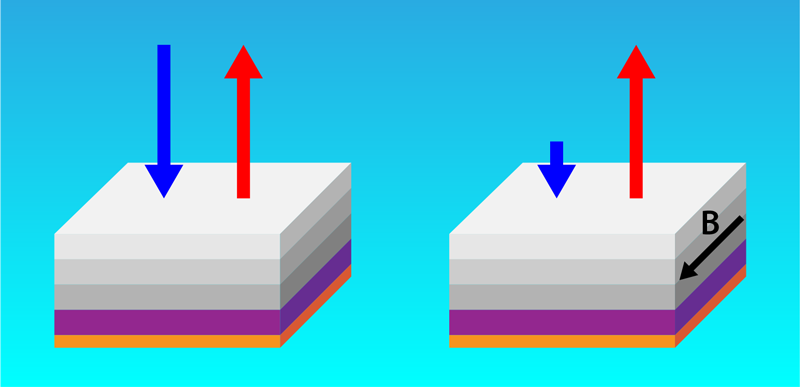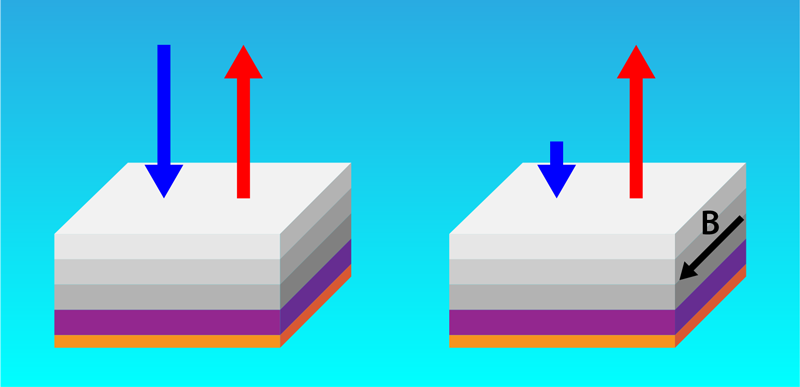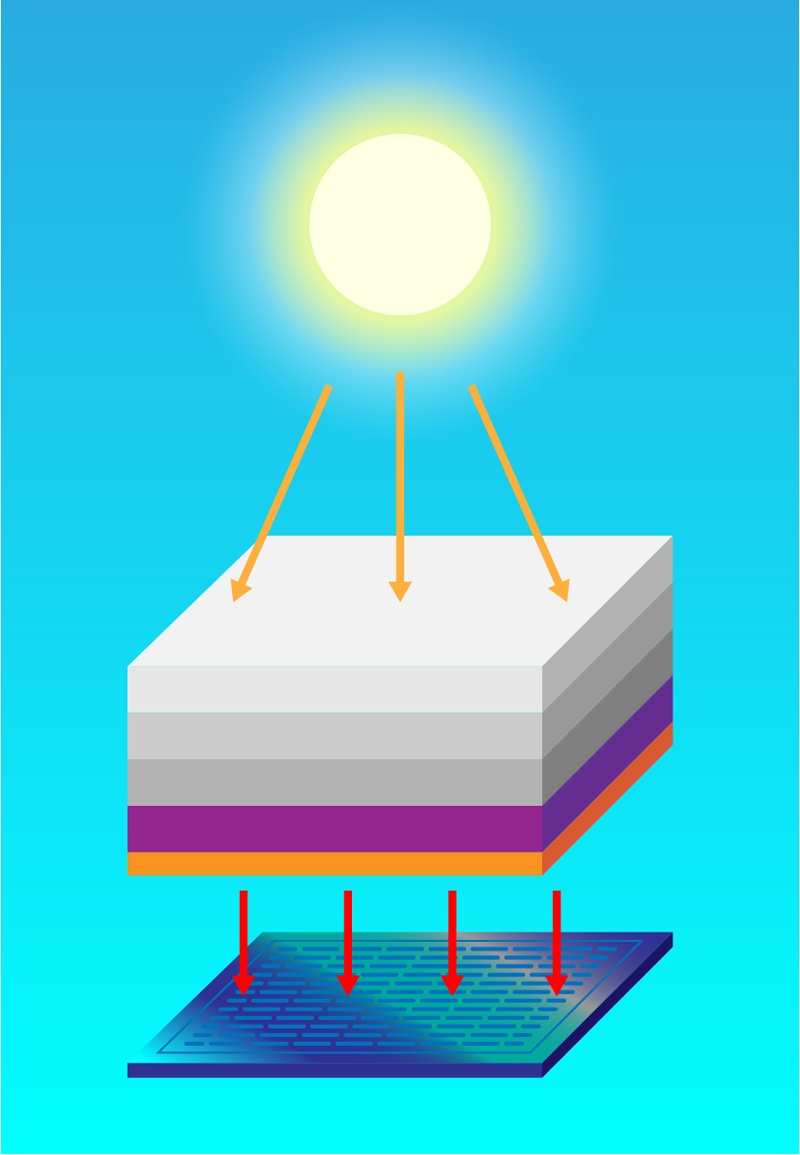Radiation Imbalance: New Material Emits Better Than It Absorbs
Hot objects glow. From the warmth of a stovetop to the invisible heat radiating from a building’s roof, thermal radiation flows outward. But it also flows inward in a reciprocal manner. This means that at thermal equilibrium, an object’s ability to thermally emit light in one direction, described as emissivity, is equal to its ability to absorb the same light coming in from the other direction, known as absorptivity. But what if this rule could be violated?
In a new study, Zhenong Zhang and colleagues from Pennsylvania State University demonstrate this exciting possibility [1]. The researchers apply an external magnetic field to a layered material, creating a system that breaks Lorentz reciprocity—a common symmetry that relates electromagnetic inputs and outputs. They then show that this nonreciprocal system exhibits much higher emissivity than absorptivity in the same direction. The observed difference between emissivity and absorptivity is twice that observed in previous experiments, thus setting a new benchmark in the field. These results pave the way for future technologies such as thermal diodes, radiative heat engines, and infrared camouflage.
Emissivity and absorptivity are both dimensionless numbers between 0 and 1, where 0 corresponds to a perfect reflector, and 1 corresponds to a perfect blackbody. Kirchhoff’s law of thermal radiation [2] states that, at thermal equilibrium, an object’s emissivity equals its absorptivity for any given wavelength, direction, and polarization, but this equality only holds for systems that obey Lorentz reciprocity. Over the past decade, theoretical studies [3, 4] have shown that when reciprocity is broken, Kirchhoff’s law can be violated without defying the second law of thermodynamics. These predictions suggest that by carefully engineering the optical environment—using materials that interact asymmetrically with light—one could build emitters that have higher emissivity than absorptivity in a given direction under equilibrium conditions. Since then, researchers have proposed methods to achieve nonreciprocal thermal radiative properties using magneto-optical effects, nonlinear materials, time-varying media, or topological materials.
Building on one of these theoretical proposals [5], my colleagues and I conducted in 2023 the first direct experimental demonstration of the violation of Kirchhoff’s law [6]. We used a magneto-optical material, indium arsenide (InAs), in a single-layer structure. A magnetic field of about 1 tesla (T) was applied, triggering cyclotron motion of electrons in InAs and a breaking of Lorentz reciprocity. However, the resulting difference between emissivity and absorptivity was 0.22—a modest nonreciprocal effect—and the bandwidth was limited.
Zhang and colleagues have achieved a much larger degree of asymmetry thanks to a stronger magnetic field (approximately 5 T) and a carefully designed photonic structure (Fig. 1). The new device consists of a structure composed of multiple layers of doped indium gallium arsenide, another magneto-optical material, deposited on a gold substrate. For doped semiconductors, the permittivity (epsilon) can go to zero at a particular infrared frequency. At this “epsilon-near-zero” condition, a photonic resonance called the Berreman mode can be excited, greatly enhancing nonreciprocal light–matter interactions. Leveraging this effect, the researchers varied the doping concentrations in the layers such that the doping gradually increased with depth, allowing a wide range of Berreman modes to be accessed. A similar layering strategy was previously employed, but with doping decreasing with depth [7].
The team employed angle-resolved magnetothermal emission spectroscopy to measure both the emissivity and the absorptivity of their device across a range of wavelengths and angles. Under an applied magnetic field of 5 T, the material exhibits an emissivity–absorptivity difference as large as 0.43 over a broad range of wavelengths in the midinfrared band (13–22 µm) and maintains this performance over a wide emission angle. The team’s design outperforms the reversed-layer counterpart [7], confirming the importance of engineering how the resonance modes are arranged.
The imbalance between emissivity and absorptivity opens the door to technologies once forbidden by reciprocity. For example, imagine the Sun or another blackbody source delivering energy to a solar cell or other energy-harvesting device. In a reciprocal system, the radiative thermal conductance between the two objects is symmetric, regardless of the direction of heat flow. This balanced exchange means that the device “wastes” photons by sending energy back to the source. But nonreciprocal behavior allows the conductance to be higher along one direction—corresponding to the high-emissivity direction—than in the reverse, enabling a radiative thermal diode. Such imbalanced conductance can be employed, for example, in an intermediate layer that can channel energy more efficiently from the source to the energy-harvesting system [8] (Fig. 2). Likewise, independent control over emissivity and absorptivity could be used to suppress thermal signatures (for stealth or camouflage) without degrading absorption efficiency.
Applying an external magnetic field is not the only way to achieve nonreciprocal thermal radiation. Materials such as magnetic Weyl semimetals [9, 10] possess intrinsic magnetic order arising from their topological band structures and broken time-reversal symmetry. These materials can support nonreciprocal thermal radiation without the hassle of applying an external magnetic field. Time modulation and nonlinear systems [8] can trigger asymmetric photonic transitions during absorption or emission, leading to fundamentally imbalanced thermal behavior. However, research in these directions remains largely theoretical, and more experimental validation is needed.
As the field matures, we may not only build better radiative heat devices but also learn to tame photon flow with new materials for power generation and information processing—an exciting frontier at the intersection of material science, photonics, and thermal science.
References
- Z. Zhang et al., “Observation of strong nonreciprocal thermal emission,” Phys. Rev. Lett. 135, 016901 (2025).
- G. Kirchhoff, “Ueber das Verhältniss zwischen dem Emissionsvermögen und dem Absorptionsvermögen der Körper für Wärme und Licht,” Ann. Phy. 185, 275 (1860).
- W. C. Snyder et al., “Thermodynamic constraints on reflectance reciprocity and Kirchhoff’s law,” Appl. Opt. 37, 3464 (1998).
- L. Zhu and S. Fan, “Near-complete violation of detailed balance in thermal radiation,” Phys. Rev. B 90, 220301 (2014).
- B. Zhao et al., “Near-complete violation of Kirchhoff’s law of thermal radiation with a 0.3 T magnetic field,” Opt. Lett. 44, 4203 (2019).
- K. J. Shayegan et al., “Direct observation of the violation of Kirchhoff’s law of thermal radiation,” Nat. Photonics 17, 891 (2023).
- K. J. Shayegan et al., “Broadband nonreciprocal thermal emissivity and absorptivity,” Light: Sci. Appl. 13, 176 (2024).
- S. Yang et al., “Nonreciprocal thermal photonics,” Nat. Photonics 18, 412 (2024).
- Bo Zhao et al., “Axion-field-enabled nonreciprocal thermal radiation in Weyl semimetals,” Nano Lett. 20, 1923 (2020).
- Y. Tsurimaki et al., “Large nonreciprocal absorption and emission of radiation in type-I Weyl semimetals with time reversal symmetry breaking,” Phys. Rev. B 101, 165426 (2020).






